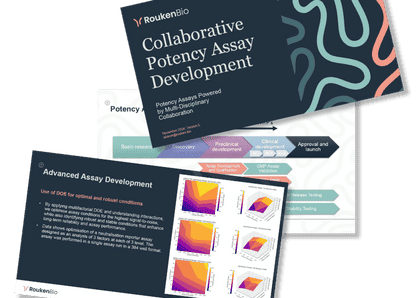Potency assay development considerations
Successful approval of biological medicinal products in the EU and US requires characterisation of the biological product’s properties to enable the setting of specifications that control the molecule’s critical quality attributes (CQA) for release into the clinic and onto the market. Release specifications ensure manufacturing lot-to-lot consistency, product stability, and ultimately, patient safety. So, what are the main development considerations? We delve into these to future-proof your potency assays.

|
October 18, 2022
|
5 min read
Successful approval of biological medicinal products in the EU and US requires characterisation of the biological product’s properties to enable the setting of specifications that control the molecule’s critical quality attributes (CQA) for release into the clinic and onto the market. Release specifications ensure manufacturing lot-to-lot consistency, product stability, and ultimately, patient safety. So, what are the main development considerations? We delve into these to future-proof your potency assays.
Defining how to measure biological activity best and what format to follow
One of the most challenging factors assay developers face is how to best define the measurements of the biological activity of interest. Potency assays should provide a quantitative measurement of a product attribute, linked to its relevant biological properties, while allowing the approaches to be adaptable. Furthermore, this initial question becomes more complex when deciding the format of the potency assay for biological products, most of which possess multiple mechanisms of action (MMOAs). What is the solution then?
Developers should adopt a more holistic approach
Assay developers often fall into the trap of thinking of their potency assay as an individual entity in the early stages of development. Unfortunately, this can be quite misleading as potency assays should never be used in isolation; they may require special equipment which cannot be operated in certain environments, or some methods can be too complex which may not be suitable for later stages. Therefore, always ensure you look at your potency assay from a wider angle and try to place it within the bigger picture to avoid difficulties.
Consider patient safety
Needless to say, the most essential factor to take into account is patient safety. The primary objective of potency assays is to guarantee product consistency by describing accurate and critical information that cannot be derived from other testing methods. Hence the potency assay should be designed and assessed to make certain that the biological activity has been determined reliably and that the assay can detect any changes that may influence it.
Join our community of curious minds on LinkedIn
🗓️ Stay informed with our monthly scientific newsletter, published on LinkedIn on the last Wednesday of each month.
These editions bring you the latest in drug development breakthroughs, industry trends, and expert insights from the brilliant minds at RoukenBio.
Subscribe today on LinkedInDiscover more on our collaborative potency assay development
Get to know all the details on the approaches and regulatory considerations for the development of potency tests of early stage biological products.
Access our technical slide deck

